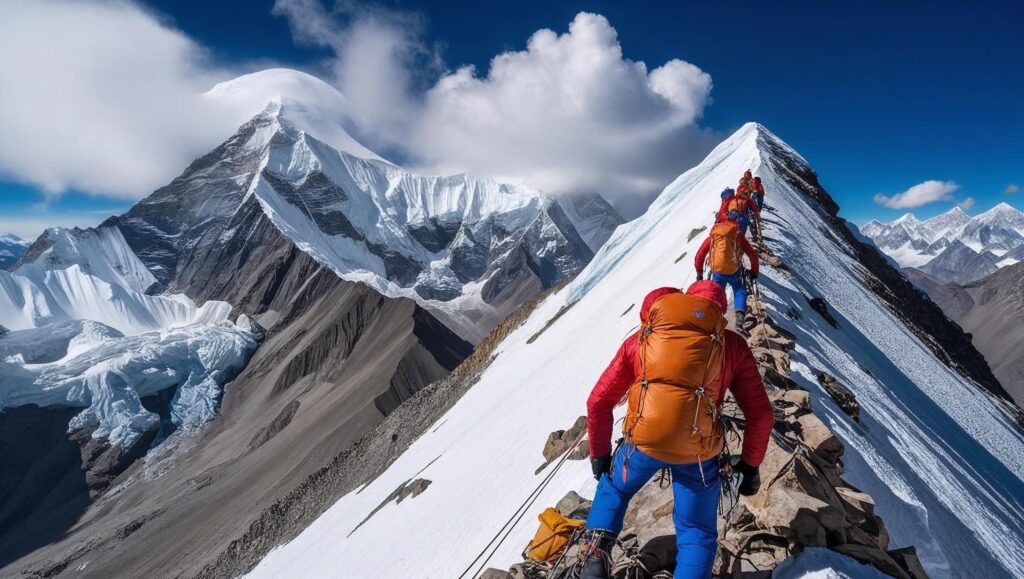Conquer Altitude: Acclimatize Like a Pro
Before you can stand on top of the world and feel the rush of success, your body needs to adapt to
extreme altitudes. Acclimatization is the process that helps you adjust to lower oxygen levels, preventing
altitude sickness and ensuring your body can keep going. It’s a gradual, strategic process that requires
training your body to thrive in thin air.
In this guide, we’ll unlock the science behind altitude acclimatization physiology and show you how
to prepare your body to conquer any summit, safely and effectively. Ready to breathe easier at 5,000
meters? Let’s get started!

Table of contents
Acclimatization Definition and Why Does It Matter?
Why You Need Acclimatization: Key Benefits
How to Acclimatize: Proven Strategies for High Altitudes
Ascend Slowly: The Golden Rule
Fuel Your Body with the Right Nutrients
Consider Medication: Diamox (Acetazolamide)
Listen to Your Body: Don’t Push Through Symptoms
How to Prepare for High Altitudes: Physical Training Tips
Ready to Reach the Summit?
Acclimatization Definition and Why Does It Matter?
First things first – let’s break down what acclimatization actually is. Put simply, it’s the process by
which your body gradually adjusts to the lower oxygen levels at higher altitudes. At sea level, the air
contains about 21% oxygen. But when you venture upwards, the air thins, and the oxygen content
decreases, making it harder for your body to absorb enough oxygen. At 3,000 meters (about 9,800
feet), oxygen levels can be as low as 14%.
This is where acclimatization comes in. It’s the process of giving your body time to adjust by
slowly adapting to the oxygen deprivation. Without this gradual adjustment, you run the risk of
developing altitude sickness, which can range from mild symptoms like headaches and nausea to more
severe conditions such as high-altitude pulmonary edema (HAPE) or high-altitude cerebral edema
(HACE). Not exactly the kind of thing you want to deal with on your trip, right?
Don’t worry, acclimatization can be your best friend when it comes to preparing your body. And
it’s not all about the physical symptoms – mental preparation and pacing are just as important.

Why You Need Acclimatization: Key Benefits
If you’ve ever asked yourself, “Do I really need to acclimatize?”, the answer is yes. Even the
fittest climbers can experience altitude sickness if they don’t give their body time to adjust to the
lower oxygen levels at high altitudes. Acclimatization improves your oxygen transport, boosts red
blood cell production, and enhances lung function – all key for maintaining performance and safety
during your climb.
Research shows that acclimatization helps your body adjust by increasing the number of red
blood cells, improving lung function, and ensuring better oxygen transport to tissues. In essence, it’s
your body’s way of becoming more efficient at surviving in challenging environments. The Centers
for Disease Control and Prevention (CDC) emphasizes that acclimatization not only prevents altitude
illness but also improves sleep quality, increases comfort, and enhances submaximal endurance.
However, maximal exercise performance at high elevations will always be reduced compared to that at
low elevations.

How to Acclimatize: Proven Strategies for High Altitudes
Ascend Slowly: The Golden Rule
This one is key: slow and steady wins the race. Rapid ascents are a recipe for disaster. As tempting as
it might be to get to the top quickly, your body needs time to adjust to the changes in oxygen levels.
Rapid ascents can cause significant physiological stress, leading to an increased risk of hypoxia
(insufficient oxygen levels), which can trigger symptoms of altitude sickness. By pacing yourself,
you allow your body to gradually adjust to the decreased oxygen levels.
The best practice is to increase your elevation by no more than 300-500 meters (1,000-1,600 feet) per
day after reaching 2,500 meters (8,200 feet). This gives your body enough time to start adapting and
prevent that awful feeling of altitude sickness.
And here’s the secret to making this even more effective: incorporate rest days. For every 1,000
meters (3,300 feet) you gain, take a day to rest. This gives your body a chance to adjust without
further stress. The strategy is called “climb high, sleep low,” and it works wonders. Your body gets
used to higher altitudes during the day, but you return to a lower elevation to rest overnight. Studies
have shown that resting at lower altitudes during acclimatization helps reduce the severity of
symptoms like headaches and fatigue.

Hydrate Like a Pro
Hydration is one of the most important factors when acclimatizing to altitude. The dry air at higher
elevations makes dehydration a real threat, and it can make the symptoms of altitude sickness worse.
Did you know that dehydration can cause dizziness, fatigue, and even headaches – three common
symptoms of altitude sickness? Staying hydrated at altitude can alleviate many of these symptoms.
Aim to drink at least 3-4 liters of water a day to keep your body functioning at its best. And
remember – avoid alcohol and caffeine, as they can dehydrate you even more.
Fuel Your Body with the Right Nutrients
Eating well is just as important as drinking enough water. Your body burns more calories at high
altitudes, so you need to fuel up properly to keep your energy levels up. Focus on eating calorie
dense, nutritious meals that provide a balance of carbohydrates, proteins, and healthy fats. Carbs, like
pasta, rice, and bread, will provide quick energy, while fats and proteins will sustain you for longer
periods. Studies found that a high-carb diet can be particularly helpful in maintaining energy levels
and preventing muscle fatigue at higher altitudes.
Consider Medication: Diamox (Acetazolamide)
For many climbers, Diamox (acetazolamide) is a useful tool to help prevent altitude sickness.
This medication speeds up the acclimatization process by stimulating your breathing and increasing
oxygenation in the blood. Before you start taking Diamox, however, it’s crucial to talk to your doctor.
While it can be a great aid, it’s not suitable for everyone. A clinical trial published in Lancet showed
that Diamox reduced the incidence of altitude sickness by up to 80%, but again, make sure it’s right
for you.

Listen to Your Body: Don’t Push Through Symptoms
At the end of the day, your body knows best. If you start feeling dizzy, lightheaded, or nauseous,
it’s time to take a step back. Don’t ignore the symptoms they’re your body’s way of telling you that
something isn’t right. If symptoms worsen, descend immediately.
How to Prepare for High Altitudes: Physical Training Tips
Acclimatization is just one piece of the puzzle. To maximize your chances of success, physical
conditioning is key. Here are a few tips to get you prepared:
Cardio: Build endurance with aerobic activities like running, cycling, or swimming. Your heart
and lungs will thank you.
Strength Training: Focus on leg and core exercises such as squats, lunges and planks to help
you handle the physical demands of climbing.
Altitude Simulation: If possible, train at high altitudes or use an altitude mask to simulate
lower oxygen levels.
Ready to Reach the Summit?
Acclimatization isn’t just about surviving at high altitudes; it’s about thriving. By following the
strategies above – ascending slowly, staying hydrated, fueling your body, and listening to your
body’s signals – you’ll maximize your chances of success and stay healthy throughout your high
altitude adventure, whether it’s the Everest Base Camp trek or another Himalayan mountaineering
expedition.
Remember: No summit is worth risking your health. With the right preparation, you can conquer
the heights and make your dream of standing atop the world a reality.
